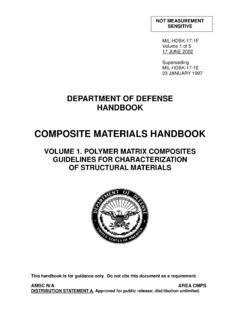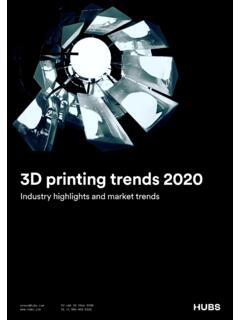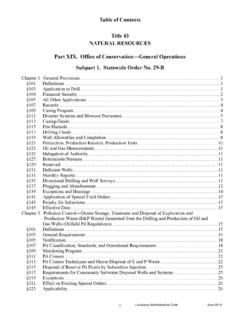Transcription of COMPOSITE MATERIALS HANDBOOK
1 NOT MEASUREMENT SENSITIVE MIL-HDBK-17-5 Volume 5 of 5 17 JUNE 2002 DEPARTMENT OF DEFENSE HANDBOOK COMPOSITE MATERIALS HANDBOOK VOLUME 5. CERAMIC MATRIX COMPOSITES This HANDBOOK is for guidance only. Do not cite this document as a requirement. AMSC N/A AREA CMPS DISTRIBUTION STATEMENT A. Approved for public release; distribution unlimited. MIL-HDBK-17-5 Volume 5, Foreword / Table of Contents ii FOREWORD 1. This COMPOSITE MATERIALS HANDBOOK Series, MIL-HDBK-17, are approved for use by all Departments and Agencies of the Department of Defense.
2 2. This HANDBOOK is for guidance only. This HANDBOOK cannot be cited as a requirement. If it is, the con-tractor does not have to comply. This mandate is a DoD requirement only; it is not applicable to the Federal Aviation Administration (FAA) or other government agencies. 3. Every effort has been made to reflect the latest information on polymer (organic), metal, and ceramic composites. The HANDBOOK is continually reviewed and revised to ensure its completeness and cur-rentness. Documentation for the secretariat should be directed to: MATERIALS Sciences Corporation, MIL-HDBK-17 Secretariat, 500 Office Center Drive, Suite 250, Fort Washington, PA 4.
3 MIL-HDBK-17 provides guidelines and material properties for polymer (organic), metal, and ceramic matrix COMPOSITE MATERIALS . The first three volumes of this HANDBOOK currently focus on, but are not limited to, polymeric composites intended for aircraft and aerospace vehicles. Metal matrix compos-ites (MMC) and ceramic matrix composites (CMC), including carbon-carbon composites (C-C) are covered in Volume 4 and Volume 5 , respectively. 5. This standardization HANDBOOK has been developed and is being maintained as a joint effort of the Department of Defense and the Federal Aviation Administration.
4 6. The information contained in this HANDBOOK was obtained from MATERIALS producers, industry, reports on Government sponsored research, the open literature, and by contact with research laboratories and those who participate in the MIL-HDBK-17 coordination activity. 7. All information and data contained in this HANDBOOK have been coordinated with industry and the Army, Navy, Air Force, NASA, and Federal Aviation Administration prior to publication. 8. Copies of this document and revisions thereto may be obtained from the Document Automation and Production Service (DAPS), Bldg. 4D, (DODSSP/ASSIST), 700 Robbins Avenue, Philadelphia, PA 19111-5094.
5 9. Beneficial comments (recommendations, additions, deletions) and any pertinent data which may be of use in improving this document should be addressed to: Army Research Laboratory, Weapons and MATERIALS Research Directorate, Attn: AMSRL-WM-MA, Aberdeen Proving Ground, MD 21005-5069, by using the Standardization Document Improvement Proposal (DD Form 1426) appearing at the end of this document or by letter. MIL-HDBK-17-5 Volume 5, Foreword / Table of Contents iii CONTENTS PART A. INTRODUCTION AND GUIDELINES PART B. design AND SUPPORTABILITY PART C. TESTING PART D. DATA REQUIREMENTS AND DATA SETS APPENDIX A.
6 DERIVATION OF THE RESIDUAL STRENGTH REDUCTION EXPRESSIONS FOR LCF AND RUPTURE LOADINGS Page Forward .. ii PART A. INTRODUCTION AND GUIDELINES ..2 1 MIL-17 GUIDELINES AND 2 INTRODUCTION .. 2 Objectives of Ceramic Matrix COMPOSITE (CMC) Working Groups .. 2 Objectives and tasks for Data Review Working Group .. 3 Vision, goals and objectives for MATERIALS and Processes Working 3 Vision, goals and objectives for Structural Analysis & design Codes Working Group .. 4 Vision, goals and objectives for Testing Working Group .. 4 PURPOSE .. 4 SCOPE .. 6 Part A: Introduction and 6 Part B: design Supportability.
7 6 Part C: Testing .. 6 Part D: Data Requirements and Data Sets .. 6 USE OF THE DOCUMENT AND 7 Source of information .. 7 Use of data and guidelines in 7 Strength properties and allowables terminology .. 7 Use of 8 Use of tradenames and product names .. 8 Toxicity, health hazards, and safety .. 8 Ozone depleting chemicals .. 8 APPROVAL 8 SYMBOLS, ABBREVIATIONS, AND SYSTEMS OF UNITS .. 9 Symbols and abbreviations .. 10 Constituent properties .. 14 Laminae and laminates .. 15 Subscripts .. 16 Superscripts .. 17 Acronyms .. 17 System of units ..20 DEFINITIONS .. 20 2 INTRODUCTION, HISTORY AND OVERVIEW.
8 43 HISTORY AND OVERVIEW .. 43 APPLICATIONS .. 44 3 PROCESSING, CHARACTERIZATION AND MANUFACTURING .. 47 CMC SYSTEMS, PROCESSING, PROPERTIES AND APPLICATIONS .. 47 CMC processing methods .. 47 MIL-HDBK-17-5 Volume 5, Foreword / Table of Contents iv Chemical vapor infiltration CMCs .. 47 CVI fabrication technique .. 47 Typical properties for CVI CFCCs .. 48 Typical applications for CVI CFCCs .. 50 Directed metal oxidation (DIMOX ) .. 50 Basic processing procedures for DIMOX .. 50 Typical properties of DIMOX .. 51 Typical applications for DIMOX .. 51 Polymer derived ceramics .. 51 51 52 Carbon-carbon composites.
9 55 Oxide systems sinter/hot press .. 56 Sol-gel processing .. 56 56 Single oxide 57 Advantages and disadvantages of sol-gel processing .. 57 Drying control agents and 59 Sol-gel processing of 2-D structures .. 60 Sol-gel processing of 3-D structures .. 60 Summary .. 61 Melt 61 Resin infiltration, pyrolysis, and 61 Slurry 62 Reaction processing .. 62 Fibrous monoliths (FMs) .. 63 63 Macrostructure of fibrous monoliths .. 64 Mechanical properties of fibrous 65 Thermal properties of fibrous 66 Applications for fibrous monoliths .. 67 Hybrid systems .. 67 FIBER/REINFORCEMENT SYSTEMS AND 67 Introduction the role and function of reinforcements in CMCs.
10 67 Continuous fibers .. 67 Oxide 67 SiC 70 Small diameter SiC-based fibers .. 72 Carbon fibers .. 73 Introduction and applications .. 73 Structure and general properties of carbon 75 Fabrication of carbon 76 Availability and sources of carbon fibers .. 79 Specific properties of carbon fibers .. 79 High temperature properties of continuous ceramic fibers .. 82 Carbon fibers .. 84 Discontinuous reinforcements whiskers, particulates, and 84 INTERPHASE/INTERFACE TECHNOLOGY AND APPROACHES .. 84 84 The roles and requirements for fiber interfaces and coatings .. 86 Fabrication of fiber interface coatings.






